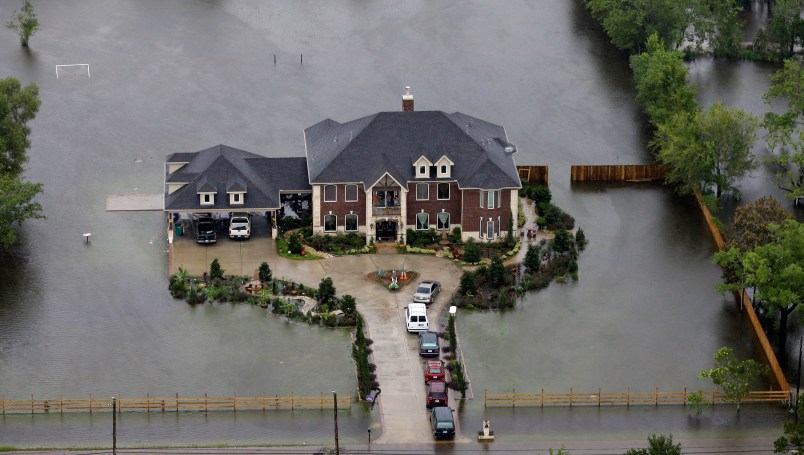HOUSTON (AP) — Harvey’s floodwaters began to drop across much of the Houston area and the sun peeked through thinning clouds Wednesday in the biggest glimmer of hope in days for the besieged city. But as the crisis eases, the storm could begin to give up its dead.
“We have good news,” said Jeff Lindner, a meteorologist with the Harris County Flood Control District. “The water levels are going down. And that’s for the first time in several days.”
The number of confirmed deaths rose to 20 when authorities reported that two men drowned on Monday. One of them drove around a barricade and into standing water, while the other tried to swim across a flooded road.
Authorities expect the toll to rise as the waters recede and they are able to take full stock of the death and destruction wrought by the hurricane.
Many thousands of homes in and around the nation’s fourth-largest city were still swamped and could stay that way for days or longer. And some Houston-area neighborhoods were still in danger of more flooding from a levee breach. Officials said 911 call centers in the Houston area were still getting more than 1,000 calls an hour from people seeking help.
Nevertheless, forecasters said the rain is pretty much over for the Houston area, and the water is already back within its channels in some places.
Also, the water in two reservoirs that protect downtown Houston from flooding was likely to crest Wednesday at levels slightly below those that were forecast, officials said.
As for Harvey, it rolled ashore early Wednesday for the second time in six days, hitting southwestern Louisiana close to the Texas state line as a tropical storm with winds of 45 mph.
But it was “spinning down” and was expected to weakend into a tropical depression sometime Wednesday, National Hurricane Center meteorologist Dennis Feltgen said. A tropical depression has winds of 38 mph or less.
From there, the remnants of the hurricane are expected to move from Louisiana into Mississippi, Tennessee and Kentucky in the next few days, with flooding possible in those states.
“Once we get this thing inland during the day, it’s the end of the beginning,” Feltgen said. “Texas is going to get a chance to finally dry out as this system pulls out.”
The reprieve from the rain in Houston was welcome.
Eugene Rideaux, a 42-year-old mechanic who showed up at Osteen’s Lakewood Church to sort donations for evacuees, said he had not been able to work or do much since the storm hit, so he was eager to get out of his dark house and help.
“It’s been so dark for days now, I’m just ready to see some light. Some sunshine. I’m tired of the darkness,” Rideaux said. “But it’s a tough city, and we’re going to make this into a positive and come together.”
The dead include a former football and track coach in suburban Houston and a woman who died after she and her young daughter were swept into a rain-swollen drainage canal in Beaumont. The child was rescued clinging to her dead mother, authorities said.
Meanwhile, the Texas community of Port Arthur found itself increasingly isolated Wednesday as Harvey’s rains flooded most major roads out of the city and swamped a storm shelter. Motiva Enterprises closed its Port Arthur refinery, the largest in the nation, because of flooding.
When Harvey paid its return visit to land overnight, it hit near Cameron, Louisiana, about 45 miles from Port Arthur.
Jefferson County sheriff’s Deputy Marcus McLellan said he wasn’t sure where the 100 or so evacuees at the civic center in Port Arthur would be sent. Most were perched on bleacher seats to stay dry, their belongings left mostly on the floor under about a foot (30 centimeters) of water, he said.
Port Arthur Mayor Derrick Freeman posted on his Facebook page: “city is underwater right now but we are coming!” He also urged residents to get to higher ground and to avoid becoming trapped in attics.
In the Houston area, Harvey’s five straight of rain that totaled close to 52 inches, the heaviest tropical downpour ever recorded in the continental United States.
Harris County Judge Ed Emmett said 30,000 to 40,000 homes, perhaps more, may have been damaged.
“It could be more,” he told Houston’s KTRK-TV. “We just don’t know. A number are irreparable. We’ve got some difficult months and perhaps years ahead.”
Some 13,000 people have been rescued in the Houston area, and more than 17,000 have sought refuge in Texas shelters. With the water still high in places and many hard-hit areas still inaccessible, those numbers seemed certain to increase.
About 195,000 people have filed for financial assistance, and about $35 million in direct aid has been distributed — numbers expected to climb dramatically in coming days and weeks, the chief of the Federal Emergency Management Agency said.
“This is going to be an incredibly large disaster,” Brock Long said in Washington. “We’re not going to know the true cost for years to come. … But it’s going to be huge.”
Harvey initially came ashore as a Category 4 hurricane in Texas on Friday, then executed a U-turn and lingered off the coast as a tropical storm for days, inundating flood-prone Houston.









